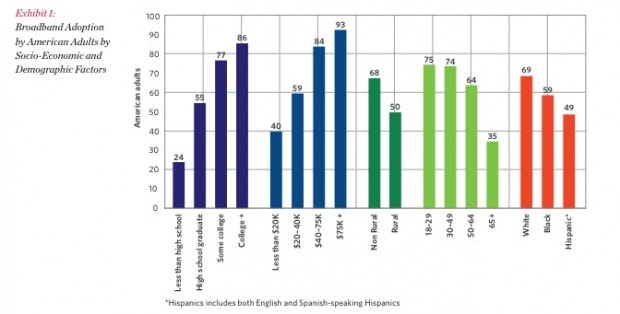According to the FCC, about 93 million Americans don’t use fast, broadband Internet, citing cost and complexity as a factor in their refusal to enter the 20th century.
The study, below, found that 80 million adults and 13 million children either still use dial-up or don’t use the Internet at all at home, suggesting that either the survey methodology might be flawed or we’re in serious trouble.
UPDATE – Also, one American doesn’t know how to use apostrophes. Fixed.
http://viewer.docstoc.com/
DOC-296442A1
Here’s the main focus:
The Federal Communications Commission’s October- November 2009 survey finds that nearly two-thirds (65 percent) of American adults use high-speed Internet con- nections to go online from home.
The FCC conducted a survey of 5,005 Americans in October and November 2009 in an effort to understand the state of broadband adoption and use, as well as barriers facing those who do not have broadband at home. The main findings are:
➤ 78 percent of adults are Internet users, whether that means broadband, dial-up, access from home or access from someplace other than home.
➤ 74 percent of adults have access at home. ➤ 67 percent of U.S. households contain a broadband user
who accesses the service at home. ➤ 65 percent of adults are broadband adopters. The dis-
crepancy of two percentage points between household and individual home use is because some survey respon- dents are nonbroadband users but live with someone who, at home, is.
➤ 6 percent of Americans use dial-up Internet connections as their main form of home access.
➤ 6 percent are Internet users but do not use it from home; they access the Internet from places such as work, the library or community centers.
In a survey of 5,005 Americans – a fairly small sample, to be sure – found that college educated Americans earning $75K+ are most likely to have broadband while the lowest penetration is in folks over 65+ and Hispanics. While this is hardly a surprise, extrapolating out to get 93 million potential non-broadband users is slightly disconcerting. Sure, the jokes here write themselves (“Oh no! The old can’t use Facebook!”), the fact that broadband is out of reach for folks in lower-income brackets and for minorities creates another educational chasm we’re going to have to deal with sooner than later.
